NSK News Bulletin Online
Jan. 2003
Newspaper Industry Prospects for 2003
Addressing Unfounded Criticism of Japan's Press Club System
(The New Year's Message of NSK President Tsuneo Watanabe)
At the outset of this new year, I would like to deliver my New Year's address.
More than one year has elapsed since the terrorist attacks on the United States. Yet the world still faces a spate of terrorist incidents, and the developments surrounding the Iraqi problem are bringing about new tension in the international community.
Meanwhile, North Korea has officially admitted involvement in the abduction of Japanese nationals and five surviving victims have safely returned to Japan. Nevertheless, Japan-North Korea talks on the normalization of diplomatic relations, which were resumed after a two-year suspension, remain stalled, mainly due to the confrontation over the abduction issue.
The Japanese newspaper industry continues to be mired in harsh circumstances. The much-disputed personal information protection bill was tentatively scrapped, but it seems almost certain that a revised bill will be submitted to the upcoming ordinary Diet session. Likewise with the human rights protection bill, we are determined to do our best to stop any legislative moves that would impair the freedom of the press.
Lately, there have been discussions about curbing newsgathering and reporting activities in preparation for the proposed introduction of a jury system as part of reforms of the judicial system. The Fire Chiefs' Association of Japan has formed a study panel to set rules on the disclosure of identities of crime or accident victims. These are just part of the conspicuous moves among public authorities to tighten regulations on the activities of media organizations. We need to be concerned about these moves.
Each media organization has taken an initiative toward resolving such problems, either through internal-examinations of news reports or by establishing knowledgeable third-party panels to conduct reviews.
When it comes to the problem of Japan's so-called media scrums, the NSK Editorial Affairs Committee in May 2002 created a subcommittee to address the matter, and voluntary efforts are in progress, as shown by publications from local consultative offices in case problems arise. In the coverage of the abduction victims who returned to Japan, such a consultative office in each affected locality functioned well to prevent any major troubles.
As for the desired functioning of the press clubs, the NSK Editorial Affairs Committee established new guidelines in January of last year. At the same time, a subcommittee to study problems related to the press clubs has been re-established in order to squarely address foreign criticisms that apparently stem from ignorance of the actual conditions. In this way, we are determined to maintain and solidify public confidence in the newspaper industry.
While striving to defend the freedoms of speech and of the press, and to consolidate their foundations, it is also a press issue to broadly expound the significance of newspapers and to help people feel familiar with newspapers.
In this context, the Newspaper Foundation for Education and Culture continuously conducts publicity campaigns to win the support of the public for the role and activities of newspaper companies through the Japan Newspaper Museum, known as Newspark, and through various "Newspaper in Education" (NIE) undertakings.
The total number of visitors to the Newspaper Museum surpassed the 100,000 mark in September of last year, and its special exhibitions organized five times a year have been getting a favorable reception. In addition, we are set to increase the number of newspaper fans through various other public relations activities, including the "Read Me." campaign and assorted competitions.
We are making steady progress toward standardization in technology. In addition to "NewsML," a standard format for transmitting article data, the Japan Committee of the International Organization for Standardization (ISO) formally adopted the specifications of a color standard for newspaper printing, dubbed Japan Color for Newspapers.
The stabilization of color reproduction in printing is being seen as a major leap forward toward broad adoption of digital transmission for the delivery of advertisement copy. And digital terrestrial broadcasting is due to be launched in Tokyo, Osaka and Nagoya toward the end of this year. The government will disclose a deadline at an early date for the termination of analog BS broadcasting. The digitalization of broadcasting is heading into full swing.
In concluding my address, I wish that the New Year turns out to be a fruitful one and I pray for your health and prosperity.
53.20 million Aggregate Newspaper Circulation in 2002
The NSK survey, "Circulation and Diffusion of Newspapers By Prefecture," has found that the daily aggregate newspaper circulation in Japan was 53,198,444 (copies) as of October 2002. That is down 0.9 percent from a year earlier, in a third consecutive year-on-year decline. If morning issues and evening issues are counted separately, the total comes to 70,815,071 copies, of which 51,517,523 are morning issues and 19,297,548 are evening issues.
The survey covered 124 NSK member newspapers, up by two newspapers from the year before. It found that the circulation of sports newspapers had dropped for a second straight year, following a 2.9 percent drop in the previous year.
According to the survey, the circulation of "set" newspapers, that is, "sets" of morning and evening editions, decreased 2.2 percent year-on-year, registering a 12th straight yearly drop. The circulation of morning editions alone increased 0.1 percent, while that of evening editions plunged 6.9 percent due in part to the termination of evening editions by Sankei Shimbun's Tokyo head office. By region, overall circulation fell in all prefectures except Okinawa, where it grew by 0.7 percent.
The average newspaper distribution per household fell 0.03 percentage points to 1.09. copies. The newspaper diffusion rate per 1,000 people was 559 copies.
AGGREGATE DAILY CIRCULATION AND DIFFUSION RATE
|
Oct. 2002 |
Oct. 2001 |
| (Aggregate circulation) |
53,198,444
(˘¤0.9)
|
53,680,753
(˘¤0.1)
|
 General-interest newspapers General-interest newspapers
 Sports papers
Sports papers
|
47,390,027
ĦĦ (˘¤0.4)
5,808,417
ĦĦ (˘¤5.1) |
47,559,052
(0.3)
6,121,701
(˘¤2.9)
|
 "Sets" of morning and evening editions "Sets" of morning and evening editions
 Morning-edition only
Morning-edition only
 Evening-edition only
Evening-edition only
|
17,616,627
(˘¤2.2)
33,900,896
(0.1)
1,680,921
(˘¤6.9)
|
18,013,395
(˘¤1.0)
33,862,600
(0.5)
1,804,758
(˘¤0.8)
|
(Diffusion rate)
|
 Circulation per household Circulation per household
|
1.09
|
1.12
|
 (Number of households) (Number of households)
 (Population)
(Population)
|
48,637,789
ĦĦ (1.3)
126,478,672
(0.2)
|
48,015,251
(1.3)
126,284,805
(0.2)
|
(Note) The figures in parentheses represent percentage changes based on a year-on-year comparison. The numbers of households and population figures are from the Basic Resident Register as of March 31, 2002.
Topics.......Topics.......Topics........
|
Press Photographers Associations Announce 2002 Awards
The local branches of the Press Photographers Association in the Tokyo, Kansai (Osaka), Hokkaido, Tohoku, Chubu and Kyushu areas have announced their annual awards for 2002.
The following is a list of some of the main recipients.
|
|
|
|
|
|
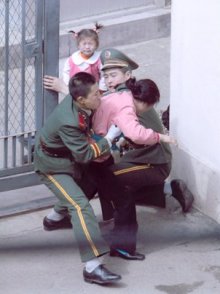 |
|
The Tokyo Press Photographers Association Award
"In Pursuit of Freedom": a photograph of North Korean asylum-seekers rushing into the compound of the Japanese Consulate General in Shenyang, China
Recipient: Tomohisa Kato
(General Bureau in China of Kyodo News)
|
|
|
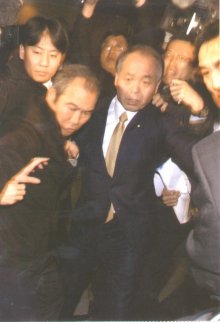 |
|
The Hokkaido Press Photographers Association Award
A photograph of disgraced politician Muneo Suzuki emerging from a hotel in Kushiro City, Hokkaido, after he quit the ruling Liberal Democratic Party over political scandals involving official aid to the Northern Territories
Recipient: Junichi Tamada
(Kushiro branch of The Hokkaido Shimbun)
|
|
|
 |
|
The Tohoku Press Photographers Association Award
"Do-Or-Die Pluck," a photograph of a firefighting helicopter attempting to rescue resident(s) stranded on a house on the Hirose River, which was flooded by rains from a typhoon
Recipient: Masayuki Sase
(Kahoku Shimpo)
|
|
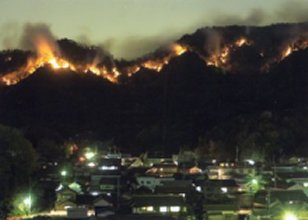 |
|
|
|
The Chubu Press Photographers Association Award
"Spreading Forest Fire"
Recipient of the General-News Division: Hiroki Samejima
(Chubu head office of The Mainichi Shimbun)
|
|
|
|
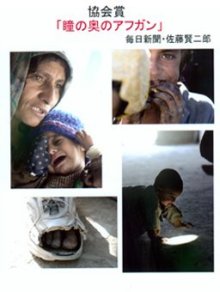 |
|
The Kansai Press Photographers Association Award
"Afghanistan In Your Eyes"
Recipient: Kenjiro Sato
(Osaka head office of The Mainichi Shimbun)
|
|
|
|
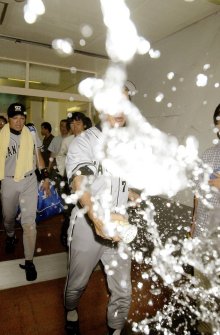 |
|
The Kansai Society of Photo Editors at Sports Papers Award
"Manager Hoshino In a Flame of Anger," photographed at the moment when his team suffered a come-from-behind defeat
Recipient: Ken Konno
(The Osaka Sankei Sports)
|
|
|
|
|
|
|
|
|
|
|
|
|
Niigata Nippo's New Printing Factory Starts Full Operations
Niigata Nippo's new printing factory, the Niigata Nippo Printing Center, started full operations on Dec. 9.
The new factory is located within the compounds of the newspaper company's head office in Niigata City, and has a total floor area of 15,906.53 square meters.
The factory features four Color-Top CT-7000 rotary presses manufactured by Tokyo Kikai Seisakusho. Each rotary press comprises two towers, three presses, one folder and five reels.
The new equipment means that the company can now print 40 pages, including 12 color pages, marking a major upgrade from the previous 32-page maximum with only eight color pages. The old printing factory in the same compounds has been shut down.
The new factory prints about 500,000 copies of the morning edition and 67,000 copies of the evening edition.
|
The Niigata Nippo is based in Niigata, Niigata Prefecture, where it publishes daily newspaper as a set of morning and evening edition with a circulation of about 500,000. |
|
<< back
Story of the month>>>
Introducing New Year's Day pages at Newspark
|
|
The Japan Newspaper Museum is sponsoring two exhibitions of newspaper issues published on New Year's Day. The exhibits have been on display since Jan. 8 at the 1st-floor lobby of the Japan Press Center Building in Tokyo's Chiyoda Ward and at the Information Plaza on the 1st floor of the Yokohama Information and Culture Center in Naka Ward, Yokohama.
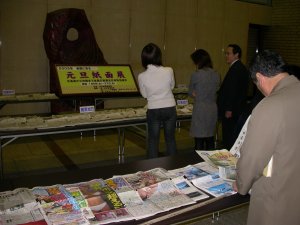 More than 100 newspapers from across the country have provided their first issue of this year for display. The large numbers of visitors are enjoying turning through the pages of the newspapers. More than 100 newspapers from across the country have provided their first issue of this year for display. The large numbers of visitors are enjoying turning through the pages of the newspapers.
The page count of Japan's newspapers on New Year's Day is generally much larger than usual. Of the more than 100 major daily newspapers, a considerable number boosted their page counts to more than 120 this year. Even though New Year's Day page counts have been falling in recent years, this year's average was close to 100 pages. The usual page count for morning issues averages between 32 and 40, with that figure tripling for New Year's Day.
The New Year's Day issue generally comprises four to six sections. In addition to the normal main section, each other section deals with politics, economy, culture, community and other categories in a manner marking the arrival of a new year and presenting the prospects for the year.
Many of these sections are composed and printed toward the end of the previous year and are delivered in advance to newspaper sales agents. In Japan, the first three days of a new year are holidays and most newspapers suspend publication on Jan. 2. But people relaxing at home for those first three days of a new year can still enjoy reading through the abundant pages and information of the New Year's Day issue.
This New Year arrived at a time of many important pending issues, both domestic and foreign. They include the United States' planned military action against Iraq, North Korea's nuclear program, the efforts to bring to Japan the families of the Japanese abducted by North Korea, and the continuing deflationary slump. Reflecting these realities, the New Year's Day issues carried headlines and texts typically speaking of "a sense of stagnation," "troubles both at home and abroad," and "disquiet."
In an apparent attempt at optimism, newspapers played up important happenings in their communities, the prevailing sentiments of the times, promising new figures in sports, culture, entertainment and other fields, as well as recipes for New Year's cuisine.
The advertisements placed in New Year's Day issues also tend to be different from those placed on other days. Instead of conventional ads featuring commercial products, many focus on corporate images and there is a higher volume of full-page color spreads.
The overall volume of newspaper advertising has been falling throughout the business slump. But that did not stop Toyota, ANA, Suntory, NTT and other major corporations from placing colorful ads in New Year's Day issues. As usual, New Year's Day issues of local newspapers were full of advertisements containing New Year's greetings in the form of enlarged business cards and announcements of the first big sales of the year at local retailers.
|
|
<< back
|
Nihon Shinbun Kyokai
The Japan Newspaper Publishers & Editors Association
Nippon Press Center Bldg., 2-2-1 Uchisaiwai-cho, Chiyoda-ku,
Tokyo100-8543, Japan
bulletin@pressnet.or.jp.
Copyright 2003 Nihon Shinbun Kyokai
All right reserved
|
|
|
|







 More than 100 newspapers from across the country have provided their first issue of this year for display. The large numbers of visitors are enjoying turning through the pages of the newspapers.
More than 100 newspapers from across the country have provided their first issue of this year for display. The large numbers of visitors are enjoying turning through the pages of the newspapers.